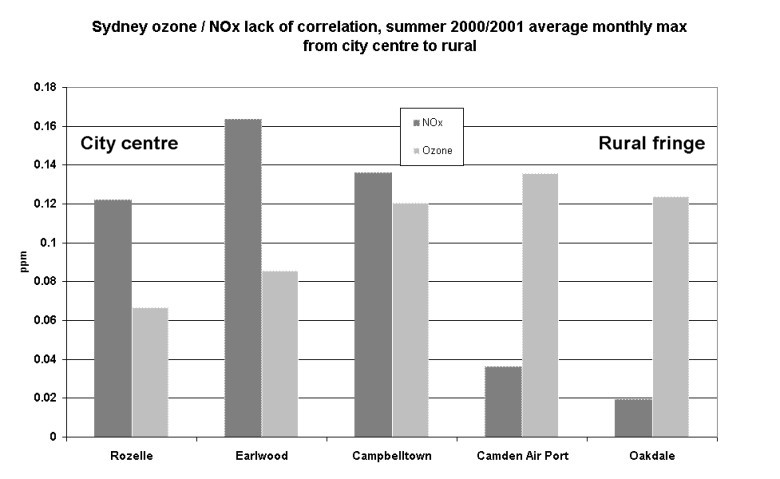Tropospheric Ozone ( Includes Urban
Ozone a component of smog)
Urban Ozone, a major component of smog, is an unstable and reactive molecule
consisting of three ozygen atoms and can be formed by the suns energy acting
with the influence of a variety of airborne catalysts. The ozone molecule
O3 is shortlived and there would be complex reactions going on both associating
into O3 and the ozone then disassociating into normal oxygen (O2) again
and the concentration of ozone at any time would depend on the energy
applied and the complex of catalysts present. A dominant view
promoted by the EPA's is that pollutant precurssors such as NOx = oxides
of nitrogen produced during combustion, (read auto engines and power plants)
and Volatile Organic Compounds (VOC's) produced from industry are
by far the most important catalysts. However the more I examine data
the more I am convinced that this is not the whole story and that much tropospheric
(lower atmosphere) ozone, which includes urban ozone of course, is in fact
natural in origin, the product of peak afternoon temperatures on hot
days acting on reactive particles in the air, not necessarily in urban areas
at all. These particles may include VOC's exuded from
soil, vegetation leaves (ever smelt pine forests or Eucalypt leaves
) or they could be from smoke, or for example sea salt particles picked
up from a brisk sea breeze driving wave top foam, as off Perth Western Australia.
Atlanta
Olympic Games ozone asthma issue
First I look at ozone in Paris during the
heat wave of August 2003 and first note the stunning correlation between
temperature and ozone peaks. Secondly, it is obvious that there is
actually an area of ozone depletion that I term the "Paris Ozone Hole"
situated right over the city, where most NOx from vehicle exhausts must
be. So I think the conventional theory of Urban Ozone formation is
shot to pieces by the Paris data.
A feature of tropospheric ozone in say the USA where we have much
data is that there are exceedences of EPA standards here and there
way out in the countryside that can not reasonably be attributed to urban
areas. There is a voluminous literature which attributes almost
magical powers of transportation for (bad) urban ozone to be blown (without
dispersion or dilution) out to pristine rural areas where exceedences occur.
California data are presented over 20 years which indicate that
most of the state exceeds EPA standards and
there is clearly no prospect of standards being met in most rural regions,
let alone in urban areas. In a nutshell, the EPA (and all the State equivalents
and their academic hangers on) are on a great funding winner here as long
as they can keep the public and legislators conned about the science. Always
demanding this and that program to fix a problem that mostly can not be
fixed because so many ozone exceedences are natural.
Next I look at the nitty gritty of hourly air monitoring
data over Perth, Western Australia and here we are lucky that for
a few years in the 1990's data was collected on Rottnest Island a little
tourist resort with very few motor cars 16 kms west of the Perth coast and
26 kms from the CBD, see map. Here we compare ozone peaks on Rottnest with
data from Swanbourne in the Perth suburbs and we find ozone peaks are very
similar, regardless of the fact the NOx is much less on Rottnest.
I think slowly the weight of facts will demonstrate that most of these
rural exeedences are are being generated not too distant from where they
are measured and it might not be great science to develop some complex
scheme to claim that wind is blowing the ozone from some distant city.
In the cases of Sydney and Melbourne what data I can
glean from their EPA web sites shows that the highest 1 hour max ozone each
year often ocurrs at a more rural location west of the cities and I bet
the Departments if asked will have some complex scheme of recirculating
winds (against prevailing westerlies) to explain why the peaks are not nearer
the CBD. This graph shows summer (Dec-Jan-Feb) average of the
three monthly maximum's for ozone and NOx for a few Sydney stations ranging
from near CBD to fringe rural and Blind Freddie can see there is no way
NOx can be the dominant cause of ozone peaks.

Of course, lead by the USA EPA, the multitude of EPA's and Depts. of the
Environment around the world, with their bloated staffs are happy
with their glib story that bad motor car exhaust emissions cause ozone =
cause smog. No need to examine that story too close.
Back to front page
I can be emailed:
Links:
California Air Resources Board (ARB), will mail a data
CD if you ask.
http://www.arb.ca.gov/aqd/aqd.htm
Galveston-Houston Association for Smog Prevention 1999 Says trees
cause up to 65% of VOC emissions in Houston area.
http://www.ghasp.org/publications/trees/TreesAndOurAir.html
Texas; Southern Oxidants Study
http://www2.ncsu.edu/ncsu/CIL/southern_oxidants/
Western Australia Department of Environment in Perth, annual AQ reports
for download
http://www.environ.wa.gov.au/
French air monitoring, you can make maps (try modelisation link), even get
limited data auto emailed to you.
http://www.airparif.asso.fr/
ASL web site, huge amount of reading and information
http://www.asl-associates.com/

